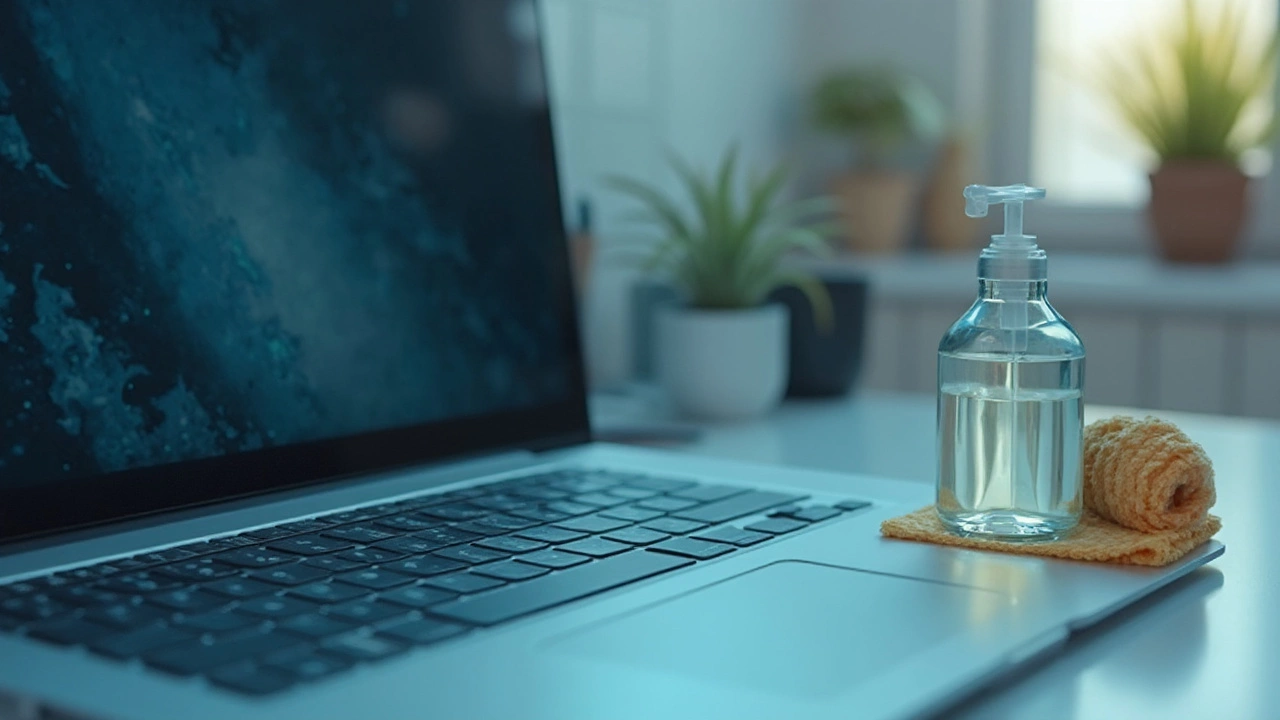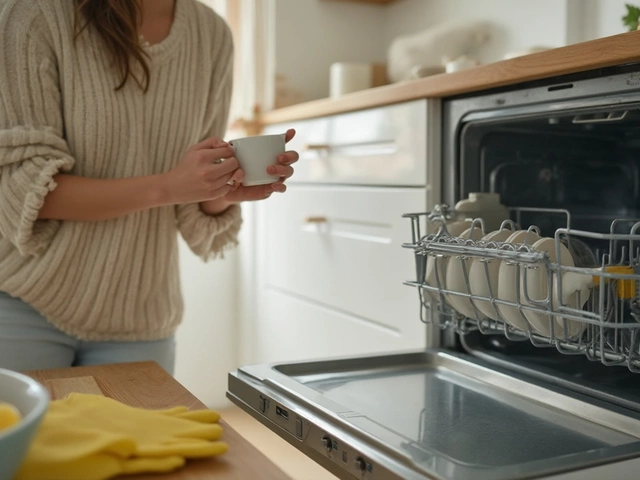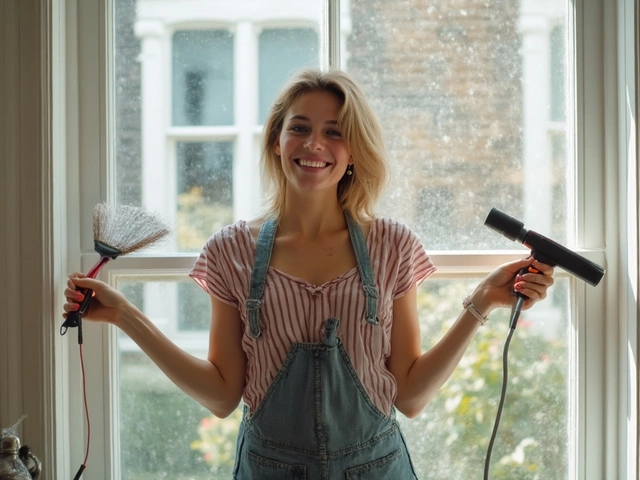Vinegar seems to be the darling of the DIY cleaning world—it’s natural, it’s cheap, and it works wonders on many surfaces. But hold up; it’s not a miracle worker for everything! Turns out, there are a bunch of spots in your home where vinegar does more harm than good.
Take stone surfaces, for example. Might seem like a great idea to splash a bit of vinegar on your marble countertop, but it’s more of a disaster waiting to happen. The acid in vinegar can react with the stone, leading to etching and a dull surface. Not exactly what you want when you’re trying to keep things looking spotless.
And if you’re someone clinging to their beautiful wooden floors, vinegar’s a no-go here too. The acidity could eat through the finish, leaving you with drab and dreary boards. Repairing that could cost much more than using the right cleaner from the start.
- Introduction to Vinegar Cleaning
- The Downside of Vinegar on Stone Surfaces
- Vinegar and Wooden Floors: A No-Go
- Avoid Using Vinegar on Tech Gadgets
- Metals That React Poorly with Vinegar
- Alternative Cleaning Solutions
Introduction to Vinegar Cleaning
This might come as a surprise, but vinegar cleaning isn't a new fad. Folks have been using this sour liquid in their homes for ages. It’s the go-to solution for many because it’s simple and environmentally friendly. But what exactly makes it such a wonder cleaner?
The secret lies in its acidity. Vinegar, particularly white distilled vinegar, is mildly acidic and can cut through grime and bacteria, which makes it super effective for cleaning various surfaces. Whether it’s for removing mineral deposits, stopping mildew, or getting those pesky coffee stains out of your mugs, vinegar does it all without harmful chemicals. That’s why it's a hit for those looking to adopt eco-friendly cleaning practices.
Plus, it’s a budget-friendly option. A big bottle of vinegar usually doesn't cost much, yet it can tackle a multitude of cleaning tasks. Here’s a neat trick: mix one part vinegar with one part water in a spray bottle, and boom—you've got yourself an all-purpose cleaner. Just keep in mind, not all surfaces are best friends with vinegar, and that’s what we’re diving into here.
Before you go pouring vinegar on everything in sight, remember that there are certain places where it’s best to keep it tucked away in the pantry. The last thing anyone wants is to inadvertently ruin a prized possession. Let's break down where NOT to use our trusty vinegar in the following sections.
The Downside of Vinegar on Stone Surfaces
Stone surfaces like granite, marble, and limestone add that classy touch to your home. They look great, but here’s a shocker—not all cleaners work well with them. When it comes to vinegar cleaning, you'll want to leave those trusty bottles for something else. The acid in vinegar can wreak havoc on these lovely surfaces!
Here's the deal: stones like marble and limestone are naturally alkaline. The acidity of vinegar can cause a chemical reaction, leading to etching—a dull, chalky look that’s hard to reverse. Imagine etching your fancy marble countertop; not ideal, huh?
Granite, while pretty sturdy, still doesn’t get off the hook. Frequent vinegar use can wear down the seal they slap on top to protect it from stains and scratches. Loose that seal, and you might as well roll out a red carpet for stains.
If you’ve ever noticed a cloudy mark on your stone surfaces after using vinegar, that’s the etching. Unlike a simple smudge you can just wipe away, reversing this damage often involves costly polishing treatments.
So, what's the best way to clean stone? It’s simple. Stick to pH-neutral cleaners. These are specifically crafted not to mess up the delicate balance of your stone. A mix of mild dish soap with water can work wonders too. Just stay clear of the acid-based stuff.
In short, while vinegar might be your go-to for many domestic dilemmas, it’s best to steer clear when dealing with these prized stone surfaces. Protect your investment, and your home will thank you.
Vinegar and Wooden Floors: A No-Go
Alright, vinegar fans, here's the scoop: using vinegar on wooden floors is a pretty bad idea. You see, while vinegar does an amazing job tackling grime on many surfaces, it's a different story when it comes to wood.
Why? It's all about the acidity. Wooden floor finishes, whether they’re waxed, varnished, or sealed, can break down when exposed to vinegar. It sneaks in past the finish, causing the wood to swell or getting dull and lifeless over time. You could end up with floors that look aged way before their time.
Imagine you've got this stunning hardwood in your living room. Instead of sprucing it up, vinegar might strip away the luster you love. It's kind of like letting a little kid loose with crayons on your freshly painted walls—not a good look.
So, what's the alternative? Here's a simple checklist to keep those wooden floors gleaming without vinegar:
- Use a pH-neutral wood cleaner—these guys are specially made to treat your floors kindly.
- Add a bit of warm water for a gentle clean-up, but remember, wood and water aren’t the best of friends, so use sparingly.
- Microfiber mop—lightweight and super effective without being abrasive.
In a pinch, even a bit of dish soap dissolved in water (think very little soap) can do wonders as a substitute cleaner. Just make sure the surface gets dried promptly to avoid any water damage. You could also try a homemade blend of olive oil and essential oils for some shine.
Keeping your wooden floors in tip-top shape is all about the approach and using the right products. Save the vinegar for other cleaning jobs to avoid risking your floors. Remember, the less you mess with the finish, the longer your floors will stay looking fabulous. Now that's a solid foundation to stand on!

Avoid Using Vinegar on Tech Gadgets
So here’s a tip that could save your gadgets from an early demise: don't clean them with vinegar. Sure, it's tempting to use a natural cleaner, especially if you spill something sticky on your laptop or phone. But vinegar's acidity might sneak into crevices, damaging screens and other electronic components.
Why? Well, the acid in vinegar can corrode the delicate parts inside your devices. Even on the outside, it could cause havoc by stripping coatings or leaving streaks on your screens. And the last thing you want is an embarrassing wavy pattern on your TV screen while you're trying to binge-watch your favorite series.
Instead, grab a microfiber cloth and some distilled water for routine cleaning. If you need something stronger, those screen-cleaning sprays specifically made for gadgets are a safer bet. Need to get into tight spots? Use a cotton swab or a soft brush to keep things tidy without the risk of damage.
Just a quick heads up: don’t spray any liquids directly onto your devices. Dampen your cloth lightly first, and you'll be good to go. Keep your favorite tech toys clean and working like champs with these simple swaps!
Metals That React Poorly with Vinegar
You might think vinegar cleaning sounds like the perfect way to shine up your metal fixtures, but think again! Not all metals appreciate a vinegar bath. In fact, it can actually speed up their run to rust town—a place no one wants their shiny kitchenware to visit.
First up on the list are aluminum surfaces. Vinegar's acidity can cause pitting and corrode the surface, leaving what looked like a sleek finish more like an old, battered suitcase. And who wants that? If it’s aluminum, keep the vinegar far away!
Now let’s chat about cast iron. Cast iron pans are a kitchen staple, but vinegar? That’s just gonna strip away your seasoning, turning your non-stick beauty into a sticky mess. Next time you’re thinking of disinfecting, use oil to polish instead and save yourself the headache.
Brass and copper items are also not fans of vinegar. They might get a shiny look initially, but over time, the acid wears them down, making them tarnish faster than you'd hope. It’s like putting vinegar and these metals in a boxing ring—strong at first, weak in the end.
Lucky for you, alternatives exist! For aluminum, a gentle soap and water mix works wonders. Cast iron? Just stick to salt scrubs. And for brass and copper, use a commercial polish that's made for the task. That way, your metals stay looking fab!
If tech specs and unintended kitchen chemistry fascinate you, here's a fun tidbit:
| Metal | Affected Reaction |
|---|---|
| Aluminum | Corrosion and pitting |
| Cast Iron | Strips seasoning, causes rust |
| Brass & Copper | Accelerates tarnish |
So, remember: when it comes to vinegar and metals, understanding the chemistry helps keep your metals looking like new. Stick to what works, and save vinegar for places where it truly shines!
Alternative Cleaning Solutions
If vinegar isn't the right fit for some of your cleaning tasks, don't fret. There are plenty of other eco-friendly cleaning solutions to keep your home sparkling without any damage risk. It's all about picking the right tool for the job, you know?
Let's start with stone surfaces, like that beautiful granite countertop. A mild dish soap mixed with a little warm water is your best mate here. Just use a soft cloth to avoid scratches, and you’re good to go.
For those gorgeous wooden floors, stick with a cleaner specifically made for wood. These cleaners are designed to keep the finish intact and the wood looking its best. Give it a spray, mop it gently, and watch the shine come alive.
Need to clean your gadgets? Skip the vinegar and go for microfiber cloths dampened with a tiny bit of water. They do a solid job of wiping away fingerprints and grime without risking any damage to those sensitive electronics.
- Glass: A DIY mix of water and a splash of rubbing alcohol works wonders on windows and mirrors.
- Metals: Use a baking soda paste for stainless steel sinks; it'll scrub off stains without scratching.
- Bathroom tiles: A little bit of hydrogen peroxide can tackle mildew and mold effectively.
Want to double-check which cleaner's best for a specific job? Check out manufacturer recommendations or eco-friendly cleaning resources online. And remember, what works for one surface might not for another, so keep experimenting until you find what clicks for you.




